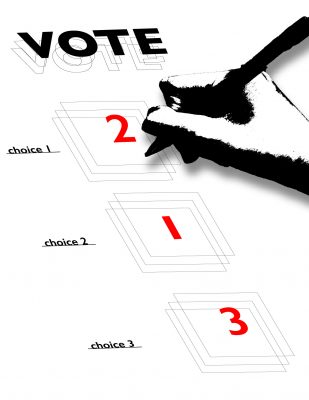Buckle up, guys, because voting season is here! Many of you have probably already voted early — in person or by mail. But for those who haven’t yet cast their ballots, let’s talk about ranked-choice voting.

Ranked-choice voting is an evaluative voting process that allows voters to rank candidates in order of preference. Let me explain.
Say you’re planning a party with friends and you have a choice between five different snacks: chips, popcorn, goldfish, fruit or a cheese board.
If you’re bougie like me, you would choose a cheese board as your first choice. But, just in case, you’re given the option to vote for others. I really don’t want fruit, so I vote chips as my second choice and popcorn as my third.
If other people don’t vote for cheese as their first choice — maybe they’re lactose intolerant — and it only gets my vote, then it will be eliminated. My vote will then be added to the vote for chips. This process continues. Candidates with the least support are eliminated, and votes are redistributed until one candidate receives a majority vote.
The existing system, plurality voting, limits voters to only one choice. Ranked-choice voting is versatile — if you wanted to select only one candidate, you have the option to do so as well.
It can be confusing at first, but once you understand the way it works, it seems pretty intuitive, right?
Ranked-choice voting matters because people deserve to see their legislators represent the issues they care about. Our current electoral system makes it extremely difficult to achieve these changes.

In September, Newton City Councilor Jake Auchincloss claimed victory in the Massachusetts District 4 Democratic primary with a mere 22.41 percent of votes, despite lacking broad appeal as a more conservative Democrat in a largely progressive district.
It was a neck-and-neck race between Auchincloss and progressive candidate Jesse Mermell, but because the progressive vote was split between several candidates, Auchincloss won with a non-majority vote.
Auchincloss’ success is only the most recent example in a pattern of non-majority wins. Between 1996 and 2016, a shocking 86 percent of district attorney races in Massachusetts with more than two candidates were won without a majority of votes.
DA races might not seem important, but they play a part in determining what the justice system in Massachusetts looks like. Time and time again, Massachusetts has shown that election results do not always accurately reflect voter wills.
To remedy this, ranked-choice voting ensures a winner will only be announced once a candidate has a majority vote.
Auchincloss’s victory was also a prime example of vote-splitting, which occurs when votes are split between similar candidates. Vote-splitting is one symptom of our flawed electoral system and highlights the ways in which our democracy upholds the political establishment and shuts down outsider candidates.
Under an evaluative voting system, voters don’t have to be as strategic. You can vote for a “risky” candidate who shares your values rather than a candidate with a better chance of winning.
Long-shot candidates — such as women, non-white, third-party and independent contenders — who have less of a chance at winning under our current system will be more encouraged to run.
As an Asian American woman, I would personally love to see more representation on a state and federal level.
Ranked-choice voting also requires candidates garner a wide range of supporters rather than relying on a small but loyal base. Thus, the elected official will be more representative of the communities they serve.
Furthermore, because candidates need to campaign for second- and third-choice votes as well, they are discouraged from mudslinging and negative campaigning because that will alienate other candidates’ supporters.
Ranked-choice voting has already been implemented in cities such as San Francisco and Minneapolis, both of which have seen higher voter turnout since then, and state-wide in Maine.
But we don’t need to travel across the country or even to Maine to see the effectiveness of ranked-choice voting. Just look at Cambridge, Mass.: it has used ranked-choice voting for its elections since 1941 and has consistently elected minority leaders onto its city council and school committee since the ‘80s.
Our own Boston University Student Government also implemented a multi-winner system of ranked-choice voting, known as the single transferable vote, for its Spring 2020 executive board elections.
“For our purposes, transferring votes ensures that every vote counts and we accommodate students’ preferences,” Daniel Daponte, co-chair of the Student Elections Commission, wrote in an email. “We will continue using the Single Transferable Voting system if we have more than two Slates running for Executive Board.”
As college students, I’m sure we all know how important voting is. But we also know how inequitable the system is. At times, we may even be tempted to not vote.
Aside from the obvious vote to cast this year — President Donald Trump vs. former Vice President Joe Biden — we can also make a difference through Question 2 on the ballot.
By voting for ranked-choice voting to start in 2022, our state’s primary and general elections will take more of our voices into account. This includes elections for state executives, state legislators and federal congressional positions.
If you’re not voting in Massachusetts, petition to have ranked-choice voting on your state ballot in the future. You can also get involved by phone banking or sign-holding at the polls. With ranked-choice voting, our votes will count even further.























































































































